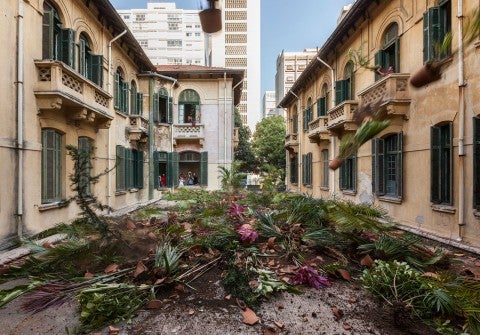Héctor Zamora (b. 1974) was born in Mexico City and lives in Lisbon, Portugal. He also lived and worked in São Paulo for several years. Consequently, Zamora’s practice reflects his interest in examining diverse geographical contexts and the social, political, and economic concerns they entail. He is known for his often subversive, disruptive actions and public interventions that critique the practices and effects of neoliberal capitalism. He documents his performances in videos that stand alone as artworks, as the angles and perspectives captured by the camera movement offer multiple views of the same scene. Zamora also typically uses traditional materials and processes in these works, as well as sculpture and installations, to suggest the ways in which they might still be politically effective in the face of cultural and technological advancements.
Zamora graduated from Universidad Autónoma Metropolitana-Xochimilco, Mexico City, in 1998. Since 2000 he has had solo exhibitions at numerous institutions, including Carrillo Gil Museum, Mexico City (2004); Museum of Contemporary Art San Diego (2007); Scottsdale Museum of Contemporary Art (2012); Redcat, Los Angeles (2013); and Palais de Tokyo, Paris (2016). Zamora has been included in group exhibitions at Museum Nacional Centro de Arte Reina Sofia, Madrid (2005); 27th Annual São Paulo Biennial (2006); 53rd Venice Biennale (2009); 54th Venice Biennale (2001); Modern Art Museum São Paulo (2011); Guggenheim Museum, New York (2013); 12th Havana Biennale (2015); and Hirshhorn Museum and Sculpture Garden, Washington, DC (2016). His awards include grants from the CIFO Cisneros Fontanals Art Foundation (2006) and the Pollock-Krasner Foundation (2007), as well as the São Paulo Biennal Foundation International Exhibition Award (2010) and the ARCO/Comunidad de Madrid Young Artist Prize (2014).
Zamora achieved greater visibility with the work Paracaidista (Urban Squatter) (2004). He researched and replicated the informal, spontaneous building techniques used in communities on the outskirts of Mexico City to construct an architectural form or house on the facade of the Carrillo Gil Museum. Zamora then resided in the edifice for three months as part of his performance. He would continue to raise concerns about the conditions and exploitation of vulnerable populations in various locations across the world. White Noise (2011) entailed the raising of five hundred white flags on a beach in Auckland, New Zealand. Their presence recalled British colonial practices of demarcating property limits. For Inconstância Material (Material Inconstance) (2012), Zamora collaborated with twenty construction workers in São Paulo to choreograph the throwing and catching of bricks throughout the gallery space. The medium implicitly refers to the manual, physical work required of the labor market, yet the play and creativity of the workers subverts power relations.
In 2016, Zamora produced an ambitious work titled Ruptura (Rupture) in the three-story Centro Cultural Banco do Brasil in São Paulo. One hundred twenty-nine people dressed in black and carrying black books leaned over the banisters of each floor. They then proceeded to tear off pages one by one, letting them fall and float into the space of the atrium creating a poetic rain of black sheets. While the performance might suggest dissatisfaction and oppression in light of political processes in Brazil and beyond, the defiant collective act of ripping the books apart was liberating. It carried a utopic message and sensation of catharsis.
The performance-installation Ordem e Progresso (Order and Progress) (2017) in Lisbon also involved cathartic action along with the physical labor of workers. Zamora installed Portuguese fishing boats in a gallery to evoke the nation’s maritime heritage, the traditional ships of which have been decommissioned over time due to technological and commercial progress. Ordem reflects the effects and consequences of these changes as well as the current migrant crisis, as performers in work clothes and hard hats destroyed the vessels with hammers and mallets. While boats once symbolized adventure and discovery, that sense of hope seems lost in the current political climate. The debris and wood left on view in the gallery appear to be connected to not only social crises and unrest but also social transformation and revolution thorough the action of the laborers.
Action is again the key to liberation in O Abuso da História (The Abuse of History). In August 2014, Zamora orchestrated the tossing of potted plants through windows into the courtyard of São Paulo’s colonial Hospital Matarazzo, an old asylum slated for demolition. The building suffered from physical decay as the institution had gone into debt. Later, various banks and investment companies bought then sold it, suggesting its devastation was the result of not only time but also the movement of large capital.
The destruction of the plants, therefore, reflects the physical and financial ruin of the hospital, yet it also recalls the practice of liberty described in Michel Foucault’s quote that often accompanies the exhibition of O Abuso. Foucault states, “I do not think there is anything that is functionally—by its very nature—absolutely liberating. Liberty is a practice.… If one were to find a place, and perhaps there are some, where liberty is effectively exercised, one would find that this is not owing to the order of objects, but, once again, owing to the practice of liberty.—Michel Foucault, interview with Paul Rabinow, 1984.”
In other words, freedom requires action. Nothing or nobody is in itself free. Steps must be taken for them to become free. Consequently, we see in Zamora’s performance the enacting of freedom, particularly from the tyranny of objects and things (considering the plans for the hospital to become a shopping mall). Ultimately, the action in O Abuso effectively plants a messy and chaotic, but nonetheless free, garden. —Kanitra Fletcher

